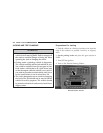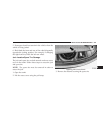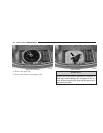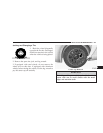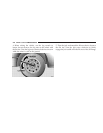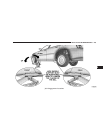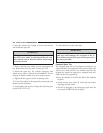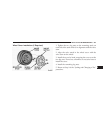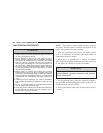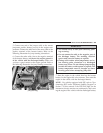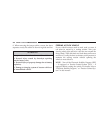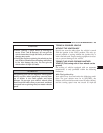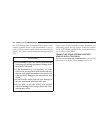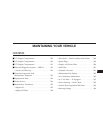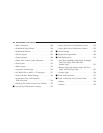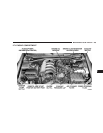
JUMP-STARTING PROCEDURES
WARNING!
• Take care to avoid the radiator cooling fan whenever the
hood is raised. It can start anytime the ignition switch is
on. You can be hurt by the fan.
• Do not attempt to push or tow your vehicle to get it
started. Vehicles equipped with an automatic transmis-
sion cannot be started this way. Unburned fuel could
enter the catalytic converter and once the engine has
started, ignite and damage the converter and vehicle. If
the vehicle has a discharged battery, booster cables may
be used to obtain a start from another vehicle. This type
of start can be dangerous if done improperly, so follow
this procedure carefully.
• Battery fluid is a corrosive acid solution; do not allow
battery fluid to contact eyes, skin, or clothing. Don’t lean
over battery whenattaching clamps or allow the clampsto
touch each other. If acid splashes in eyes or on skin, flush
contaminated area immediately with large quantities of
water.
• A battery generates hydrogen gas, which is flammable
and explosive. Keep flame or spark away from the vent
holes.
• Do not use a booster battery or any other booster source
with an output that exceeds 12 volts.
• The battery in this vehicle has a vent hose that should not
be disconnected and should only be replaced with a
battery of the same type (vented).
NOTE:
The battery is stored under an access cover in
the trunk. Remote battery terminals are located in the
engine compartment for jump-starting.
1. Wear eye protection and remove any metal jewelry
such as watchbands or bracelets that might make an
inadvertent electrical contact.
2. When boost is provided by a battery in another
vehicle, park that vehicle within booster cable reach, but
do not allow the vehicles to touch one another.
WARNING!
Do not permit vehicles to touch each other as this
could establish a ground connection and personal
injury could result.
3. Set the parking brake, place the automatic transmis-
sion in PARK, and turn the ignition switch to the OFF (or
LOCK) position on both vehicles.
4. Turn off the heater, radio, and all unnecessary electri-
cal loads.
282 WHAT TO DO IN EMERGENCIES



